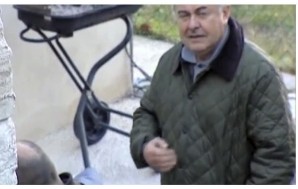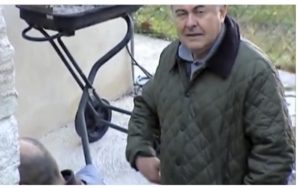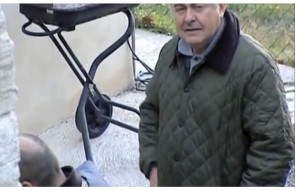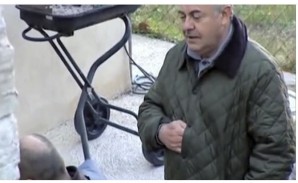
The fourth indication Knox was framed by Italian police for the murder of Meredith Kercher, is Giuuliano Mignini himself. As Public Minister in Perugia, Giuliano Mignini was both the lead investigator and prosecutor in the case against Amanda Knox and Raffaele Sollecito, and the real question behind the bizarre claims Mignini hurled at the defendants and Knox in particular, is what he himself actually believed.
In the above picture, from the recent documentary “Is Amanda Knox Guilty”, on the first day of investigation at the Kercher crime scene, we see Mignini in a familiar repose. Familiar at least if one happens to be Napoleon Bonaparte.
In this brief video clip, Mignini is looking over the shoulder of one of his investigative team at the cottage on the first day of the Kercher murder investigation, his right hand is half buried in his coat, a la Napoleon. When Mignini notices he’s on camera, he hurriedly withdraws his hand, and places it in his pants pocket. These are the actions of a man who doesn’t actually believe he’s the historical character ‘Napoleon’. He simply likes to pretend that he is, and is embarrassed when discovered doing so. He knows it’s silly, but its a silly pleasure.
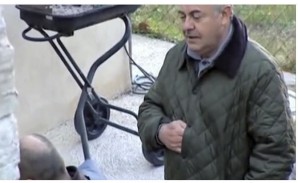
But what are we to make of Mignini’s charges that Knox and Sollecito killed Meredith Kercher in a ‘rite related to Halloween’, as Mignini originally claimed in the Kercher case? Did Mignini believe that too, or was it just more ‘pretend time’?
CAREER ADVANCEMENT AND THE NARDUCCI INVESTIGATION
Mignini’s original theory in the Kercher case, was provided by a self-styled psychic medium and satanic cult expert, Gabriella Carlizzi. Ms Carlizzi, a wealthy widow in Rome, claimed to receive her “illuminations from a dead priest and vatican exorcist, Father Gabriel, who had died in 1984. Mignini had used Carlizzi’s theories similarly in the past, repeatedly.
Mignini had used Carlizzi’s theories in cases that he prosecuted in 2002 (Dr Narducci), 2006 (Mario Spezi), 2008 (a Florentine pharmacist Calamandrei), 2009 (The Kercher case), and in 2010 (a case against 20 people in Florence, including the father and brother of Dr Narducci). Thus far, although rejected by the lower courts, the Italian Supreme Court of Cassation has not found the ‘satanic sect conspiracy’ Mignini has claimed in his cases to exist, but they have not rejected the theory either.
But Mignini’s adoption of Carlizzi’s satanic murder conspiracy theories is not necessarily as crazy as it may seem at first glance. On the contrary, Mignini may well have seen such investigations as a proven path to career advancement in Italy, owing to the experiences of previous investigators in the Monster of Florence cases.
In 2002, Mignini had used Carlizzi’s theories as a basis for involving himself in the Monster of Florence crimes, a series of horrific murders in and around Florence from roughly 1968 through 1985. The Italian police manhunt for the perpetrator was the largest criminal case in Italian history.
The other competing theory, was that of the satanic cult ritual murder, which drew enormous interest and credibility in Italy. After a failure to convict on the single perpetrator theory, the ‘Sardinian Trail’ line of inquiry was formally closed, despite the fact that it had been well developed and in all probability actually true. The ‘group crime’ team of investigators pursued the satanic cult aspect, and won a conviction against a Tuscan man named Pacciano. Domestically violent and guilty of raping his daughters, Pacciano was an unsympathetic defendant, and convicted in a national show trial. The Monster of Florence crimes had “been solved”, at least by outward appearances.
After Pacciani was convicted, the investigators who had, ‘solved the case’ received high profile promotions. Although the Pacciano case fell apart on appeal, with the prosecutor actually arguing for acquittal because the case was so obviously bogus, the Italian Supreme Court of Cassation set aside Pacciano’s acquittal and ordered a retrial. Pacciano died two days before his retrial was due to begin. But the lesson Mignini may well have drawn, is that pursuing the ‘satanic cult’ theory in any case that can be related to the Monster of Florence cases, was a fast track to career advancement.
In trying to understand Mignini’s behavior in the Kercher case, it is also useful to examine his behavior in these previous cases.
A VENGEFUL PROSECUTOR WHEN OTHERS DISAGREE; THE NARDUCCI FAMILY & MARIO SPEZI
In the Narducci affair, the Carlizzi/Mignini theory was such that Dr Narducci was affiliated with the satanic masonic cult that they believed was behind the Monster of Florence crimes, and that Dr Narducci had reservations about his continued participation in the cult, and that his cult colleagues had him murdered to guarantee his silence. Moreover, that the body of Doctor Narducci had been switched with another corpse, so as to conceal the crime. All Mignini needed to do, he reasoned, was exhume the corpse to prove the body switch.
Over the objections of the Narducci family, Mignini had the body exhumed, and the corpse was found to be the doctor himself. On this basis, Mignini theorized that the cult members had gotten wind of Mignini’s plans, and stealthily managed to have the real body switched back, in a so-called ‘double swap’.
Rather than accept that he had made an error in his theory of the crime, Mignini claimed that the family’s objection to his investigation and to exhuming their family member was based not on the pain associated with becoming part of Mignini’s circus, but because of their involvement in the ‘satanic cult’ which Mignini was seeking to expose. Mignini would later charge the grieving members of Narducci’s family, including the father and brother, as being part of the ‘satanic cult’ responsible for the young doctor’s drowning. That case would later be dismissed before trial in 2010 in Florence.
Mario Spezi and Douglas Preston were researching their book on the crimes, “The Monster of Florence”, and crossed paths with Mignini during these times. MIgnini would later charge Spezi himself as being the actual “Monster of Florence”, based on Carlizzi’s writings as well, after Spezi had been ridiculing Mignini and his colleague Guitarri’s satanic cult theories on a national TV show in Italy in 2004. In 2006, Mignini had Spezi imprisoned in pre-trial detention, just as he did with Knox and Sollecito. Dougklas Preston helped generate an international protest demanding Spezi’s release, which was granted about 3 weeks later, after journalists in Italy joined the protests. Mignini later archived the indictment against Spezi, although claims against Spezi would be later revived, and are active today.
Spezi’s only fault here, was in objecting to Mignini’s investigation, and like the Narducci’s before him, he would become embroiled as targets of Mignini’s Monster of Florence investigations because of it.
For Mignini, it couldn’t be that Spezi was ridiculing Mignini and Guitarri, because they were pursuing a ridiculous theory of ‘satanic cults’ that couldn’t possibly be true. The only answer for Spezi’s opposition to Mignini’s investigations was that Spezi himself was the leader of the very cult Mignini was trying to expose. Again, the psychic Carlizzi was behind the allegations used against Mario Spezi, a fact which brought renewed ridicule to Mignini.
It was Spezi’s arrest and imprisonment that caused Douglas Preston to instigate a campaign to free Spezi, in the US and in Italy. Many people believe it was the international embarrassment suffered by Italy in this incident which led to Spezi’s release, and Guitarri’s ‘monster squad being disbanded. When Guitarri complained to Mignini that his requests for more resources were being thwarted, Mignini responded with unauthorized wire taps on officials in Florence and journalists whose reporting Mignini found objectionable. These and other excesses were the basis of the abuse of office charges leveled against Mignini and Guitarri, and for which they had been indicted two weeks before the Kercher killing.
When Mignini was temporarily blocked in his pursuit of Spezi, Mignini then pursued a case against a Florentine pharmacist Francesco Calamandrei, coincidentally a friend of Mario Spezi. Calamandrei first came to the attention of the ‘Monster of Florence’ investigators when his severely schizophrenic wife wrote a letter denouncing her husband. Though investigated and rejected at the time, Mignini sought to revive the case.
Time and again, it seems Giuliano Mignini simply must be prosecuting someone for involvement in the elusive ‘satanic sect’ cult he claims exists, in his Monster of Florence criminal investigations. When one case is rejected, Mignini finds another to take its place. And truth, justice and actual innocence all appear to be a casualty of Mignini’s lust for career advancement. It is breathtaking the depraved indifference Mignini repeatedly demonstrates, feeling entitled to destroy the lives of innocent people whom he sweeps up into his fantastical prosecutions, solely to advance his own career.
Mignini’s reactions to people who challenge the legitimacy or logic of his investigations is consistent, and terrifying. Whether Mignini believed his ‘satanic masonic sex cult’ claims or not, the fact is Mignini’s commitment to a plainly false disproven theory guaranteed that many innocent people, mostly Italians, would be swept up in his pursuit of members of his imaginary cult, or ‘their agents’, for over a decade since 2002. Amanda Knox and Raffaele Sollecito are only Mignini and Carlizzi’s latest victims.
IS GIULIANO MIGNINI HIS OWN PRIVATE NAPOLEON?
So again, we are left struggling with the enigma that is Giuliano Mignini, what does he truly believe? Let us now turn to Mignini’s own writings for an answer.
Mignini has evidenced an interest in Napoleon, indicated by the posing image of him at the top of this article, and also as he wrote about in one of two articles Mignini authored (“The Viva Maria” and “Justice Denied” ) viewable on the ‘Catholic Alliance’ website. A brief review of these articles gives us some insight into what Mignini believes, and how he sees himself in the world. (Google translate may not have done Mignini justice in his writing).
In both articles, Mignini approvingly refers to the “counter-revolutionary” nature of his subjects. The second Mignini article, is a book review from 1992, describing changes in Italian criminal procedure. Mignini provides quotes railing against the “progressive de- Christianization of society and abandonment, while at the individual and institutional, an objective order of values of reference”. MIgnini unmistakably views his role as a prosecutor as a religious duty, and himself as a religious warrior in a kind of ‘catholic jihad’.
Mignini also complains that the changes in the law will complicate the process of obtaining convictions. There is a flavor of Mignini’s lack of concern over safe guarding the rights of the accused, and the opposition he displayed at the Hellman acquittal to the notion of ‘proof beyond a reasonable doubt’. What matters to Mignini most apparently, is achieving convictions, plain and simple. “Innocence”, is something which seems oddly peripheral to Mignini’s mindset.
But more instructive and revealing to Mignini’s true mindset, is the first article. “The ‘Viva Maria’ “, which describes a local uprising against an invasion of the Perugia locale by the forces of Napoleon. In this uprising, the local inhabitants took up the war cry “Viva Maria” to rise up against foreign invaders. Mignini appears to transfer his modern beliefs onto historical characters and situations.
In Mignini’s view, The ‘Viva Maria’ uprising was, ‘like all counter-revolutionary phenomena’, a popular uprising in defense against the imposition of foreign values on to the local people’s ‘religion, culture and heritage’. Mignini describes the Italian resistance to the French, as an “abstract message and ideological conflict”, and, “with the historical and religious identity of the thousands of Italian small countries…”. The choice of language is interesting, and revealing.
In Mignini’s view, Italy’s small towns and local populaces are each their own little countries, bound together only by local religious values and a shared cultural heritage. With this perception in mind, and as the Public Minister of Perugia, Mignini seeing in himself a kind of ‘Napoleon of Perugia’, an unchallenged military dictator protecting his citizenry from encroaching modernity, begins to make sense.
MIgnini writes about this imposition of foreign values; “…in a brutal manner and without mediation of any kind – to secularize the institutions and subvert the root of the traditional forms of expression of sovereignty and representation policy, destroying centuries-old and criminalizing the existing state entities, and imposing new cultural and political models. The people will rise up almost immediately, because it is Pressed by the charges and the robbery of the occupant, either because they perceive the ideological alienation of the French, having not so much as foreigners but as bearers of a worldview hostile to the “common sense” that still survives in the society of the Old Regime.” (Again, my apologies if Google translate doesn’t do him justice).
In the above passage we can begin to see Mignini’s rage at Amanda Knox as a free spirited American, a living contradiction and insult to Mignini’s core values. In prosecuting Amanda Knox, it is foreseeable that Mignini may be motivated by his genuine religious fervor in rejecting Knox’s secular inclinations, and in his view, protecting the cultural values of his community from foreign influence.
But most troubling of all, Mignini also describes religious miracles, relating to ‘sightings of Maria’, that gave impetus to the uprising; “… just in Arezzo, in 1795, violent riots occur, even with religious implications. The Miracle of 15 February 1796, when un’annerita image of Our Lady of Consolation bleach before the eyes of some craftsmen, is the first of a series of similar incidents have occurred in many other parts of the Grand Duchy and neighboring areas, where they are seen statues or images of the Madonna move his eyes or cry. Marian devotion, already strong in Western Tuscany and Umbria, is enhanced by these miracles, and is the engine of the future uprising.”
In Mignini’s view, these religious miracle events are real, actual, genuine, and historical truths. There is no reason to doubt his beliefs in ‘satanic cult rituals’, which he has pursued in the Narducci, Spezi, Calamandrei and Kercher cases, are also real to him. Not merely real in the sense that the people who commit “satanic cult sex murder crimes” mistakenly believe they are in league with the devil and are criminals who must be punished. But rather, that they actually are manifesting the ‘devil’s work’ on earth by denying the fundamental religious beliefs to which Mignini subscribes, “an abstract and ideological conflict”, in Mignini’s words. Mignini isn’t just chasing ‘satanic sects’ – Mignini genuinely thinks he’s chasing Satan.
In this context, the absence of evidence against Knox and Sollecito need not give too much pause to Mignini. If statues of the Madonna can cry, then surely agents of the devil could commit a violent murder while leaving no trace of themselves. In this writer’s opinion, Giuliano Mignini is a legitimate madman. A modern day inquisitor spinning satanic conspiracies and instigating literal witch hunts in a modern European country. Manufacturing evidence, coaching tramp witnesses, destroying exculpatory evidence, are all merely the tolls of the trade for this rogue prosecutor pursuing his claims against the innocent. Mignini isn’t after the truth or justice for the victims: he only wants convictions, and he pursues them by whatever means necessary.
WHAT DOES MIGINI BELIEVE?
That Mignini and the Italian police intentionally framed Amanda Knox has been argued in three previous articles, referring to a first(link), second(link) and third(link) indications of intentional framing. We could easily add another chapter on the vagabond circus of unreliable witnesses Mignini has paraded in court, in this and other cases. And we have touched on the motivation of Giuliano Mignini and the Perugian authorities(link), at least on the surface, of trying to blame Amanda Knox for Meredith Kercher’s murder, rather than accepting their own responsibility for having failed to control Rudy Guede, the true sole perpetrator of the crime – a failure in judgement, competence and professionalism that ultimately cost Meredith Kercher her life.
But none of this can begin to explain Mignini’s personal fixation with Amanda Knox: putting up her portrait in his office to stare at and obsess over during the days; the vehemence with which he pursued her incarceration; his repeated pattern of lies in the most devastating manner about her character and the case in the press; the sheer violence with which he denounced her in court, seeking life imprisonment with 9 months of solitary confinement – the harshest penalty available in the Italian justice system – all the while knowing she was innocent. Again, why?
Mignini has been described as a Jeckyll and Hyde character. Friendly and likable outside the courtroom, but once inside and pressing his case, it is as though another darker personality takes over. Mignini appears to exist in a twighlight world between fantasy and reality, that the very aspersions of character he sought to portray in Amanda Knox are projections of his own worrisome nature. Sadist, narcissit, becomes angry when others disagree, has a dual nature, and so on. Outwardly calm, but on the inside possessed by demonic rage. Who does that describe really – Amanda Knox or Giuliano Mignini?
THE TRUEST IMAGE OF DR MIGNINI
The truest insight into Mignini’s character that I’ve come across in my readings on the case is a from Candace Dempsey’s “Murder In Italy”. The last day of the 2009 trial where Knox and Sollecito were convicted, Amanda Knox pled one last time for her freedom. After Knox had finished and was ushered out of the courtroom, Dempsey writes; “Prosecutor Mignini hurriedly left the room, right after Amanda. Delaney Knox, Amanda’s eleven year old sister, was standing on the other side of the bronze door when he came through it and went down the hall. ‘He was crying’, she said.
Continuing; “The next day, Mignini let it be known that he had not wept after seeing Amanda Knox plead for her freedom. Absolutely not, he insisted, it wasn’t true. He’d merely felt hot and gone into the bathroom to dab water on his face. That accounted for the moisture. If Mignini wept for Amanda, then he must have cried crocodile tears. He and Manuela Commodi ended the prosecution case that same day. They asked the court for the highest possible penalty, life in prison, based on counts of murder and sexual violence. Life meant thorty years, the same sentence given to Rudy Guede, but MIgnini felt Amanda deserved more. He wanted the twenty-two-year-old American to endure nine months of solitary confinement.”
Mignini cried. And that’s why Giuliano Mignini deserves to spend the rest of his life in prison for what he did to Amanda Knox. He knew Knox was innocent, he was touched by her plight, and he didn’t stop. Mignini behavior was pre-meditated and deliberate over the full four year period. Guede had murdered Meredith Kercher, because he felt entitled to take Meredith’s life. But Guede’s acts were not pre-meditated. Giuliano Mignini felt entitled to steal Amanda Knox, and to steal Raffaele Sollecito, as he had stolen so many people like them in his farcical fanciful deranged efforts to advance his career, climbing over the wreckage of ruined innocent lives.
The Kerchers will only find closure in recognizing the truth that their Meredith was killed by Rudy Guede alone, and with no one else. And the only way they will know that Knox and Sollecito had nothing to do with that terrible crime, is by holding accountable those responsible for this miscarriage of justice – from PM Mignini on down; Napoleone, Figarra, Zugarini, Stefanoni, Giobi and all the other who had a hand in intentionally framing two innocent college students.
CLOSING ARGUMENT
The last thought I’ll leave with, is the image of Giuliano Mignini at the first appeal trial before Judge Hellman, arguing in closing once again that Amanda Knox must receive a life sentence in prison, starting with nine months of solitary confinement, the harshest punishment allowable under Italian law, and normally reserved for only the worst criminals. Raging in the courtroom at Amanda Knox, and Raffaele Sollecito, two people whom he knew to be innocent, yet trying to destroy their lives simply for the benefit of saving his tattered career, and shredded reputation. Feeling his hostage slip away from him, a young college girl he had literally kidnapped from her family four years earlier and kept in a cage, claiming she would make an escape to her home in America if the court set her free. In desperation, he almost seemed to be begging Judge Hellman, when he said, “don’t let the black boy pay alone!”. Giuliano Mignini may very well have been pleading for himself.
Hold in your mind the image of a person who would try to destroy two young people, knowing them both to be completely innocent, just to save himself some professional embarrassment. Try to imagine such a monster. From the very beginning, Mignini seemed to have decided, someone would have to be destroyed by this case, and for some reason he seemed to make it, either him or Amanda Knox. Maybe he thought she was an easy mark, and he could steal her life without breaking a sweat. She had no chance to avoid him then, but she does now. I know who’s side I’m on. How about you?
In the next article, I’ll try to address the role of the Italian judiciary in the intentional framing of Amanda Knox and Raffaele Sollecito.
 Wrongful Conviction News an Injustice anywhere website
Wrongful Conviction News an Injustice anywhere website

